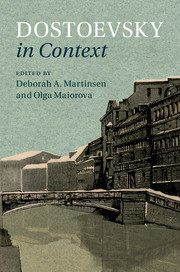Book contents
- Frontmatter
- Contents
- List of illustrations
- Notes on contributors
- Acknowledgments
- Note on citation, transliteration, glossary, and dates
- Chronology
- 1 Introduction: the many worlds of Dostoevsky
- PART I SOCIAL, HISTORICAL, AND CULTURAL CONTEXTS
- PART II LITERATURE, JOURNALISM, AND LANGUAGES
- 25 Modern print culture
- 26 Realism
- 27 Dostoevsky: translator and translated
- 28 Travel and travel writing
- 29 Folklore
- 30 Foreign languages
- 31 Theater
- 32 Dostoevsky's journalism and fiction
- 33 Dostoevsky's journalism in the 1860s
- 34 Dostoevsky's journalism in the 1870s
- 35 Censorship
- Glossary
- Further reading
- Index
- References
25 - Modern print culture
from PART II - LITERATURE, JOURNALISM, AND LANGUAGES
Published online by Cambridge University Press: 18 December 2015
- Frontmatter
- Contents
- List of illustrations
- Notes on contributors
- Acknowledgments
- Note on citation, transliteration, glossary, and dates
- Chronology
- 1 Introduction: the many worlds of Dostoevsky
- PART I SOCIAL, HISTORICAL, AND CULTURAL CONTEXTS
- PART II LITERATURE, JOURNALISM, AND LANGUAGES
- 25 Modern print culture
- 26 Realism
- 27 Dostoevsky: translator and translated
- 28 Travel and travel writing
- 29 Folklore
- 30 Foreign languages
- 31 Theater
- 32 Dostoevsky's journalism and fiction
- 33 Dostoevsky's journalism in the 1860s
- 34 Dostoevsky's journalism in the 1870s
- 35 Censorship
- Glossary
- Further reading
- Index
- References
Summary
Dostoevsky's engagement with print culture informed aspects of his art that resonate with today's readers, who live in a world of rapidly changing media. Patterns of thinking and self-expression as well as the nature of truth in a universe of proliferating information became core concerns in Dostoevsky's work as he plunged into the life of a writer, journalist, editor, and publisher, becoming more familiar with all aspects of Russian press culture than most of Russia's nineteenth-century major writers. Pressed into professional writing for life, Dostoevsky assimilated print culture into his art as he explored the human condition in a mediated world.
Dostoevsky grappled with the intellectual confusion and moral chaos caused by a social order in continual flux at a time when educated Russians were transitioning into modern life. The forces of modernity – including the progress of technology, the development of industry and commerce, the growth of education, bureaucracy, and liberal professions – were gradually transforming Russia throughout the nineteenth century. Whereas social transformation across the country proceeded slowly, informational conditions in St. Petersburg and Moscow changed rapidly as print media developed faster than other aspects of modern life. An overabundance of new information put into question many traditional assumptions, such as those associated with faith in God, service to the crown, and belonging to a family, a community, and a social estate. In the new print culture, literature became a prominent agent negotiating between varying modes of knowledge in a way that made the newly mediated world seem more comprehensible to the educated public.
Dostoevsky came of age as modern print culture, which involves a communally shared media discourse, was emerging in Russia's capital cities. During the 1830s, in a cultural turn described at the time as “the commercialization of letters,” the press gained institutional viability based on economic success. By the 1840s, half a dozen long-lasting periodicals had been reliably producing the over 2,000 copies required for financial survival, and some print runs edged past 5,000. Print runs were not an accurate indication of readership, however. The audience for each issue of a newspaper or journal was several times greater: copies were shared among family members, colleagues at work, fellow students, patrons of lending libraries, and the clientele of pubs and cafes.
- Type
- Chapter
- Information
- Dostoevsky in Context , pp. 221 - 228Publisher: Cambridge University PressPrint publication year: 2016

